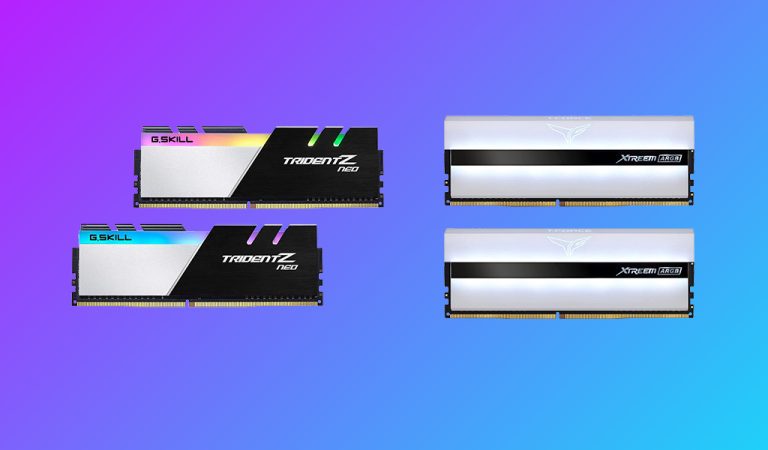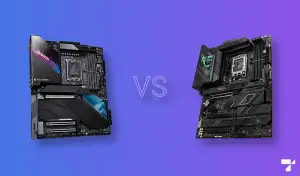The Ryzen 7 5800X3D processor is one of AMD’s biggest experiments prior to AM5. This is because the final CPU of the Zen 3 series is the very first commercial run of the company with its signature 3D V-Cache technology. This bumps the 32MB L3 cache of the original Ryzen 7 5800X to a whopping 96MB, in exchange for a slightly lower (negligible) core clock, and disabling standard overclocking options. This makes it one of the best gaming processors on the market. Therefore, we have created this guide on the best RAM for the Ryzen 7 5800X3D.
As we all already know, cache, alongside memory speed, has been a very critical component of Ryzen’s success. The same is true with Ryzen 7 5800X3D, as optimal memory speeds with better timings could allow the CPU to further utilize its design specialty in fetching common processes.
AMD Ryzen 7 5800X3D RAM Sweet Spot
For the RAM sweet spot of the Ryzen 7 5800X3D processor, you should look to acquire a memory module kit(s) that has at least 16GB or 32GB capacity, with a preferred 3200Mhz or 3600Mhz frequency, and latency of at most CL18. You should of course consider opting for tighter timings (lower latency) of 16CL when buying a lowering clock frequency RAM kit such as 3200Mhz for the Ryzen 7 5800X3D CPU which is more ideal in terms of cost to performance.
What to Look for When Buying RAM for the Ryzen 7 5800X3D
RAM Capacity – 16GB (8GB x2) has been the sweet spot for standard PC builds for a good while now, and it continues to be even as we welcome DDR5 memory for current LGA1700 (Intel) and future AM5 socket motherboards later in 2022. Though, if you coming from a Ryzen 7 upgrade anyway, you might as well increase the RAM to 32GB (8GB x4) to significantly lessen your system’s dependence on Page File management. Consider going 64GB (16GB x4) only if you have a specific use case for it (preferably a professional application).
Memory Frequency – 3600Mhz modules have been circulating for quite a while now, and are generally available at very affordable prices, so that should be your target RAM frequency for the late-release Ryzen 7 5800X3D. That higher frequency RAM will also give you better resale value in the future. However, you can of course purchase a 3200Mhz kit(s) at tighter CL timings for very similar performance to its 3600Mhz counterpart and save a bit of money in the process.
Memory Timings – second to frequency, having considerably low timings also greatly helps in speeding up the performance of your RAM stick. Your default latency target for DDR4 (in accordance with the target of this article) should be CL18 or CL16 for 3600Mhz, CL16 or CL14 for 3200Mhz, and go as low as possible.
Dual-Channel VS Single-Channel – minimum one stick for each channel (two or four), period. It’s a free performance bump in memory bandwidth that is absolutely necessary for any PC build, especially when it comes to Ryzen CPUs. Going single-channel is completely out of the question.
Best RAM for Ryzen 7 5800X3D
G.Skill Trident Z Neo
Verdict: Best Overall RAM for Ryzen 7 5800X3D
Sports a very clean modern design that fits most build aesthetics, enough RGB for similar purposes, and most convenient of all, its plug, set XMP, and play with great performance in terms of speed and latency
Specifications
Memory Type: DDR4 | Capacity: 32GB (2x16GB) | Speed: 3,600MHz | CAS Latency: 16 | Timings: 16-19-19-39 | Voltage: 1.35V | Height: 43mm/1.7″ | Warranty: LifetimeBenefits
- Solid build quality (literally)
- Standard design fits any visual theme, even no RGB!
- Efficient heat spreader design
Drawbacks
- A bit on the expensive side
First of all, this definitely is not a bias towards the Triden Z Neo series. Besides, the popularity of this particular model speaks for itself. While being somewhat less on the price-to-performance side, it is still offered at very reasonable prices. It has a bit of everything, after all, and can be a good investment if you want an easily swappable set of RAM for any DDR4 system.
As for its performance, the two 16GB sticks work as expected with its default XMP options. CL16 checks out well with its 3,600Mhz clock speed. However, you also have good wiggle room for tightening its timings further, or by experimenting with higher frequencies on two sticks. Temperature control is a non-issue, as the heat spreaders may not even be a significant factor as you reach 1.4V.
Visually, the Trident Z Neo has a somewhat basic design. Not too basic, but just standard enough that it can easily slip into any theme for any build without looking like an eyesore. Its Lightning Control Software does its job of switching between single colors, and even when turned off, it still looks perfectly okay.
So, the verdict is as usual. This particular kit strikes a nice balance for aesthetics while being reliable enough that a bit of a price bump isn’t really going to matter. With or without the additional internal case lighting.
Corsair Vengeance RGB Pro
Verdict: Best Runner Up RAM for Ryzen 7 5800X3D
The Corsair Vengeance RGB Pro has a slightly unique heat spreader with a cool RGB design that fits with almost any build aesthetic. Its also has great performance when paired with Ryzen systems due to its high frequency and low latency.
Specifications
Memory Type: DDR4 | Capacity: 32GB (2x16GB) | Speed: 3,600MHz | CAS Latency: 16 | Timings: 16-18-18-36 | Voltage: 1.35V | Height: 51mm/2″ | Warranty: LifetimeBenefits
- Very stable (variable?) CL timing adjustability
- And it doesn’t even need that much tweaking in the first place
- Works on a wide variety of configurations
Drawbacks
- Tall heat spreader
- Harder to use on smaller systems
If you want a slightly different-design alternative to the Trident Z Neo, then the Corsair Vengeance Pro series becomes the obligatory choice. Negligible performance difference (fast and reliable as usual), while offering a different aesthetic choice for the user.
Technically, there is a very slight variation in CL timings using its XMP profiles. Well, it’s better on paper. But, this provides no discernible difference, especially when the user isn’t actively looking at benchmarked values. If you’re the type to love tweaking your RAM, though, this module kit still offers quite a good amount of headroom to mix and match. In fact, you can play with it a bit more than the Triden Z Neo, though this is more of an optimization feature than actually squeezing performance (that is already maxed out).
As for which is the better economic choice, it depends on the promos and discounts available at the online store of your choice. Corsair usually has the better lead in frequency alone despite both being at a premium, so you might find yourself favoring the Vengeance RGB Pro simply for the saved money.
G.Skill Ripjaws V
Verdict: Best Value RAM for Ryzen 7 5800X3D
If Trident Neo Z isn’t your thing, then going half-step down to Ripjaws is the next best thing. Plain and simple out-of-the-box reliability, with a decent heat spreader design.
Benefits
- Optimal price-to-performance value
- Wide experimentation with dual-channel OC
- Simple, thick-base design
Drawbacks
- Visual design could use a tiny bit of improvement
Ripjaws modules never seem the best looking, and always felt like were a holdover from the early 2010s era of heat spreader design. But it just works, and its aesthetic has enough flair for any minimalist build. Besides, it’s never a pushover in performance.
What’s strange, though, is the generally higher RAM profile of the module compared to its barebones counterparts. This isn’t exactly a problem for standard builds even when populating four DIMM sticks. But it does stick out more than usual, emphasizing its simple, all-black looks further. But hey, at least the kit is significantly cost-competitive to the point that its heat spreaders might even be considered product-based assets.
Performance-wise, there’s nothing much to say. It’s a reliable 3200Mhz kit that elevates the performance of any current-generation Ryzen processor with no drawbacks. Though, we do highly recommend finding a way to tweak the modules to get CL14 latency for the OC enthusiasts out there.
Teamgroup T-Force Xtreem
Verdict: Best Premium High-Frequency Low Latency RAM for Ryzen 7 5800X3D
Yes, that entire white area you see is its addressable RGB space. Pricey ambient themes aside, it is ironically one of the go-to RAM for untweaked frequency and latency cost efficiency.
Specifications
Memory Type: DDR4 | Capacity: 32GB (2x16GB) | Speed: 3,600MHz | CAS Latency: 14 | Timings: 14-16-16-37 | Voltage: 1.35V | Height: 49mm/1.9″ | Warranty: LifetimeBenefits
- Very huge ARGB area
- Surprisingly unhindered thermal performance
- Best default frequency and latency combo
Drawbacks
- Very expensive
- Tall-ish heat spreader
Don’t be fooled by the huge area of its ARGB components. The T-Force Xtreem offers its lighting features as more of an ambiance type of glow, rather than the expected bright illuminating spectacle it seems to be advertised for. Still, this alone is enough to instantly catch the attention of PC shoppers, at least before they get a good look at the kit’s price tag.
As we have already assessed, the combination of 3600Mhz and CL14 is tricky to achieve with manual tweaks. It is darn impressive if you can do it. But if you can’t, this RAM pair can provide it for you as a simple XMP profile. Though, we have to stress once more, that unless your application is heavily cache and memory dependent, you won’t feel the performance difference without benchmark numbers.
Oh and about that weirdly stable thermals? It’s a combination of the widely stretched-out heat spreader and the previously mentioned fact that it’s not really too bright. No worries about premature failures, especially within the price tier it’s competing on.
If money is of no contest, we suggest burning funds for at least a kit pair of this aesthetic and performance-optimized beast. You won’t be disappointed either way.
Corsair Vengeance LPX
Verdict: Best High-Capacity RAM for Ryzen 7 5800X3D
This is the pair of RAM for those in search of nothing but the best capacity-to-price ratio with no sacrifice to performance. Probably not for those who prefer better-designed heat spreaders, though.
Specifications
Memory Type: DDR4 | Capacity: 64GB (2x32GB) | Speed: 3,200MHz | CAS Latency: 18 | Timings: 18-22-22-42 | Voltage: 1.35V | Height: 33mm/1.32″ | Warranty: LifetimeBenefits
- Low-profile, easy to install
- Very huge capacity at a super competitive cost
- Simply, plug and play use
Drawbacks
- Need to double-check for automatic memory profiles
For people who don’t want to spend money on RGB and fancy aluminum designs, Corsair’s Vengeance LPX has always been a slightly more premium choice. It hits the nail on the head with good enough frequency and timings, even allowing users to get the most capacity per unit cost. Which is like, the very first immediately noticeable specification outside stability benchmarks.
In fact, with this particular set of Corsair Vengeance LPX modules, you already get professional-tier, hyper multi-tasking level capacity at the cost of the previously featured T-Force Xtreem. To be fair, default CL18 timings might not be the best with its already “low” 3200Mhz frequency. But you should be able to tighten it down to CL16 with the right tweaks. Yes, right tweaks. Some of its out-of-the-box XMP profiles might not match the spec combination you are looking for.
As for its design, the industrial line certainly isn’t for everyone, and we could argue that something like the Ripjaws is objectively better variation-wise. But it’s not bad, certainly not worse than a barebones memory stick. Besides, if raw aluminum heat spreader design is what you are looking for…
Teamgroup T-Force Vulcan Z
Verdict: Best Budget RAM for Ryzen 7 5800X3D
Affordability must come with performance efficiency, which this pair of RAM fulfills very nicely. Heat spreader design is on the simpler side. But is still fancy enough to work for certain builds.
Specifications
Memory Type: DDR4 | Capacity: 16GB (2x8GB) | Speed: 3,200MHz | CAS Latency: 18 | Timings: 16-18-18-38 | Voltage: 1.35V | Height: 32mm/1.26″ | Warranty: LifetimeBenefits
- Very cheap, yet doesn’t have performance drawbacks
- Negligible heat spreader height
- Stylish aluminum design that doesn’t rely on RGB or deep blacks
Drawbacks
- Aesthetic and color variation is not for everyone
For those in need of something really cheap, like even cheaper than Ripjaws modules, then the T-Force Vulcan Z is always available as the next best alternative. It essentially fulfills the design philosophy of saving more, without giving up more.
Again, like the Vengeance LPX, we see a bit of a disconnect between its 3200Mhz speed and CL18 timing. This will affect certain memory-intensive applications very slightly, but thankfully not to the point of negative use. If you have time, we recommend playing with its configurations a bit and see if you can tighten these to at least CL16 latency. This is probably its only significant difference compared to the specific Ripjaws modules featured here.
Like always, the V-shape design of Vulcan modules provides a different tinge of aesthetic flair compared to other RAM of more industrial designs, especially the ones that rely more on RGB. It helps it stand out, though depending on the color scheme of your system, you may, or may not need to find a different-colored version of it.
It is also worth noting that the heat spreader height is so low that it can essentially be considered negligible. Not as discreet as our last entry below, but is more than enough that can be considered a serious contender.
Kingston Fury Beast
Verdict: Best Low-Profile RAM for Ryzen 7 5800X3D
Speaking of low-profile, if you want to get as close to having almost zero heat spreaders while still having a decent aesthetic, then these memory modules should easily be right up your alley.
Specifications
Memory Type: DDR4 | Capacity: 32GB (2x16GB) | Speed: 3,600MHz | CAS Latency: 18 | Timings: 18-22-22-40 | Voltage: 1.35V | Height: 34mm/1.34″ | Warranty: LifetimeBenefits
- “Undying” mechanical heat spreader design for more than a decade
- Low profile, but somehow very stylish with the border accents
- Tweaks and configuration options are of no issue
Drawbacks
- Zero premium feel
Along with the classic LPXs, Vulcans, and Ripjaws, comes an even simpler design by Kingston’s Fury Beast modules that had never changed since the days of the first generation Intel Core CPUs. Because why even change it? Its faux mechanical sections make it suitable for any build not just aesthetically, but via spacing considerations as well.
Technically speaking, the Fury Beast is only a smidge lower than something like a Corsair Vengeance LPX. But unlike those modules that focus more on side design, Fury Beast sticks still maintain their visual appeal at the top. This combination of looks and functions allows it to trump all others listed here, and thus, gain our best low-profile title.
The performance value for this RAM kit is actually very decent for its price. It does fine, has the minimum specs that you need, has a good balance of latency and frequency, and can run at its intended XMP settings right out of the box. No potential issues whatsoever. Its 32GB capacity is also perfect for its price, competing well within its intended price tier.
Do take note that these modules come in different color flavors, as well as RGB versions that swap out its faux mechanical sections with light bars. Be sure to match them you want to the specific design of the Fury Beast module that you need.
Ryzen 7 5800X3D FAQs
How Much RAM Do I Need for the Ryzen 7 5800X3D?
Standard capacity-wise 16GB should be plenty enough for all modern tasks and applications, including high-end gaming. That being said, we highly suggest bumping it up to 32GB anyway to further optimize the multitasking and multiprocessing capabilities of the CPU.
Final Thoughts
The Ryzen 7 5800X3D was an excellent, albeit somewhat late SKU that provided the last stretch of upgrades for the AM4 platform using the much anticipated 3D V-Cache technology. While its price and tier may no longer be sensible for those who jumped to Zen 3 two years ago, it remains a nice optional choice for AMD users who might have been waiting for that final 300 series chipset upgrade to jumpstart older Zen 1 and Zen+ units. This is along with, of course, the beauty of AMD’s memory overclocking freedom at the mid-tier, opening the latest DDR4 memory modules to these same old motherboards.



